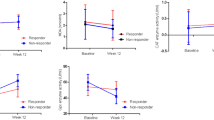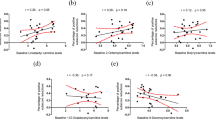Summary.
The debrisoquine oxidation phenotype was determined in 91 schizophrenic patients on monotherapy with different neuroleptics and in 67 untreated healthy volunteers.
The prevalence of poor metabolizers of debrisoquine was significantly higher in the patients (46.2%) than in the healthy subjects (7.5%). Treatment with phenothiazine antipsychotics (chlorpromazine, levomepromazine and thioridazine) was associated with a higher debrisoquine metabolic ratio than treatment with haloperidol. On the other hand, treatment with clothiapine appeared not to interfere with debrisoquine oxidation.
Oral administration of 50 mg thioridazine daily to 8 healthy subjects resulted in a marked increase in the debrisoquine metabolic ratio and 4 of them were transformed into phenotypically poor metabolizers.
The results confirm the fact that phenothiazines, and to a lesser extent haloperidol, inhibit the oxidative metabolism of debrisoquine. They show also that clothiapine administration does not disturb the debrisoquine metabolic ratio.
Similar content being viewed by others
References
Mahgoub A, Idle JR, Dring LG, Lancaster R, Smith RL (1977) Polymorphic hydroxylation of debrisoquine in man. Lancet II: 584–586
Eichelbaum M, Spannbrucker N, Steincke B, Dengler HJ (1979) Defective N-oxidation of sparteine in man: a new pharmacogenetic defect. Eur J Clin Pharmacol 16: 183–187
Jacqz E, Hall SD, Branch RA (1986) Genetically determined polymorphisms in drug oxidation. Hepatology 6: 1020–1032
Brosen K (1990) Recent developments in hepatic drug oxidation. Implications for clinical pharmacokinetics. Clin Pharmacokinet 18: 220–239
Nebert DW, Nelson DR, Adesnik M, Coon MJ, Estabrook RW, Gonzalez FJ, Guengerich FP, Gunsalus IC, Johnson EF, Kemper B, Levin W, Phillips IR, Sato R, Waterman MR (1989) The P450 superfamily: updated listing of all genes and recommendeed nomenclature for the chromosomal loci. DNA 8: 1–13
Brosen K, Gram LF (1989) Clinical significance of the sparteine/debrisoquine oxidation polymorphism. Eur J Clin Pharmacol 36: 537–547
Eichelbaum M, Gross AS (1990) The genetic polymorphism of debrisoquine/sparteine metabolism. Clinical aspects. Pharmacol Ther 46: 377–394
Steiner E, Iselius L, Alvan G, Lindsten J, Sjöqvist F (1985) A family study of genetic and environmental factors determining polymorphic hydroxylation of debrisoquin. Clin Pharmacol Ther 38: 394–401
Speirs CJ, Murray S, Boobis AR, Seddon CE, Davies DS (1986) Quinidine and the identification of drugs whose elimination is impaired in subjects classified as poor metabolizers of debrisoquine. Br J Clin Pharmacol 22: 739–743
Brosen K, Gram LF, Haghfelt T, Bertilsson L (1987) Extensive metabolizers of debrisoquine become poor metabolizers during quinidine treatment. Pharmacol Toxicol 60: 312–314
Inaba T, Jurima A, Mahon WA, Kalow W (1985) In vitro inhibition studies of two isozymes of human liver cytochrome P-450: mephenytoin p-hydroxylase and sparteine monooxygenase. Drug Metab Dispos 13: 443–448
von Bahr C, Spina E, Birgersson C, Ericsson O, Goransson M, Henthorn T, Sjöqvist F (1985) Inhibition of desmethylimipramine 2-hydroxylation by drugs in human liver microsomes. Biochem Pharmacol 34: 2501–2505
Fonne-Pfister R, Meyer UA (1988) Xenobiotic and endobiotic inhibitors of cytochrome P-450db1 function, the target of the debrisoquine/sparteine type polymorphism. Biochem Pharmacol 37: 3829–3835
Syvalahti EKG, Lindberg R, Kallio J, de Vocht M (1986) Inhibitory effects of neuroleptics on debrisoquine oxidation in man. Br J Clin Pharmacol 22: 89–92
Derenne F, Joanne C, Vandel S, Bertschy G, Volmat R, Bechtel P (1989) Debrisoquine oxidative phenotyping and psychiatric drug treatment. Eur J Clin Pharmacol 36: 53–58
Benitez J, Piñas B, Garcia MA, Martinez C, Llerena A, Cobaleda J (1989) Debrisoquine oxidation phenotype in psychiatric patients. In: Dahl SG, Gram LF (eds) Clinical pharmacology in psychiatry: from molecular studies to clinical reality. Springer, Berlin Heidelberg New York, pp 206–210
Spina E, Buemi AL, Sanz E, Bertilsson L (1989) Diazepam treatment does not influence the debrisoquine or mephenytoin hydroxylation phenotyping tests. Ther Drug Monit 11: 721–723
Lennard MS, Silas JH, Smith AJ, Tucker GT (1977) Determination of debrisoquine and its 4-hydroxy metabolite in biological fluids by gas chromatography with flame ionization and nitrogen selective detection. J Chromatogr 133: 161–166
Evans DA, Mahgoub A, Sloan TP, Idle JR, Smith RL (1980) A family and population study of the genetic polymorphism of debrisoquin oxidation in a white British population. J Med Genet 17: 102–105
Nordin C, Siwers B, Benitez J, Bertilsson L (1985) Plasma concentrations of nortriptyline and its 10-hydroxy metabolite in depressed patients — relationship to the debrisoquin hydroxylation metabolic ratio. Br J Clin Pharmacol 19: 832–835
Gram LF, Debruyne D, Caillard V, Boulanger JP, Lacotte J, Moulin M, Zarifian E (1989) Substantial rise in sparteine metabolic ratio during haloperidol treatment. Br J Clin Pharmacol 27: 272–275
Kallio J, Huupponen R, Seppala M, Sako E, Iisalo E (1990) The effects of β-adrenoceptor antagonists and levomepromazine on the metabolic ratio of debrisoquine. Br J Clin Pharmacol 30: 638–643
Mikus G, Ha HR, Vozeh S, Zekorn C, Follath F, Eichelbaum M (1986) Pharmacokinetics and metabolism of quinidine in extensive and poor metabolizers of sparteine. Eur J Clin Pharmacol 31: 69–72
Jorgensen A (1986) Metabolism and pharmacokinetics of antipsychotic drugs. Progr Drug Metab 9: 111–174
Balant-Gorgia AE, Balant L (1987) Antipsychotic drugs. Clinical pharmacokinetics of potential candidates for plasma concentration monitoring. Clin Pharmacokinet 13: 65–90
von Bahr C, Guengerich FP, Morin G, Nordin C (1989) The use of human liver banks in pharmacogenetic research. In: Dahl SG, Gram LF (eds) Clinical pharmacology in psychiatry: from molecular studies to clinical reality. Springer, Berlin Heidelberg New York, pp 163–171
Dahl-Puustinen ML, Liden A, Alm C, Bertilsson L (1989) Disposition of perphenazine is related to the polymorphic debrisoquine hydroxylation in man. Clin Pharmacol Ther 46: 78–81
Gram LF, Fredricson Overo K (1972) Drug interaction: inhibitory effect of neuroleptics on the metabolism of tricyclic antidepressants in man. Br Med J 1: 165–175
Alvan G, Bechtel P, Iselius L, Gundertremy U (1990) Hydroxylation polymorphisms of debrisoquine and mephenytoin in European populations. Eur J Clin Pharmacol 39: 533–538
Author information
Authors and Affiliations
Additional information
Data from all the subjects in the study can be obtained from the authors on request
Rights and permissions
About this article
Cite this article
Spina, E., Martines, C., Caputi, A.P. et al. Debrisoquine oxidation phenotype during neuroleptic monotherapy. Eur J Clin Pharmacol 41, 467–470 (1991). https://doi.org/10.1007/BF00626371
Received:
Accepted:
Issue Date:
DOI: https://doi.org/10.1007/BF00626371




